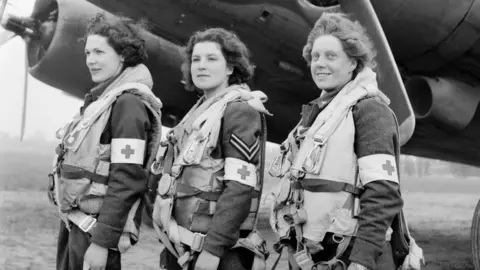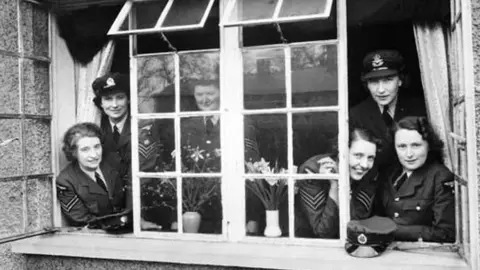Flying Nightingales: Women who flew into WW2 battles celebrated
 Imperial War Museums/Getty Images
Imperial War Museums/Getty ImagesA display has opened to celebrate the work of a group of women who risked their lives being flown into battle to treat soldiers during World War Two.
Known as the Flying Nightingales, the women delivered supplies to troops and evacuated injured men, all while coming under enemy fire.
They began the work after D-Day nearly 80 years ago, but since then many of their stories have been forgotten.
The exhibition is on show at London's Florence Nightingale Museum.
The women had been working as nursing orderlies as part of the Women's Auxiliary Air Force (WAAF) when in March 1944 the Air Council approved for them to be flown into scenes of battles to deliver equipment and bring back casualties for treatment in the UK.
 Florence Nightingale Museum
Florence Nightingale Museum"Their sole role was to basically keep the men comfortable and administer basic fist aid," explains Florence Nightingale Museum's general manager Katie Edwards.
"They had specific training on battle wounds, how to deal with burns, how to give injections, that kind of thing. And then they would have been required to stay with the men all the way back to the UK."
The first flights took place a week after the Normandy landings in June 1944, with Cpl Lydia Alford among three women landing on the north coast of France.
Recalling what happened later, she described how she was particularly struck by "the dust which was everywhere, coming up in great clouds".
"While the freight was being unloaded I tried to make the wounded men as comfortable as possible in all that dust. I had water to give them and panniers of tea," she said.
 Florence Nightingale Museum
Florence Nightingale MuseumFor the rest of the war the three women and many others were flown across Europe in specially adapted RAF planes that could carry up to 24 casualties. Soon they became known as the Flying Nightingales after the famous "Lady of the Lamp".
Two of them, Margaret Walsh and Margaret Campbell, were killed in action and Ms Edwards says the women had to carry out their work in the face of "extraordinary risk".
"On the flights out to France they were carrying ammunition, which meant that they weren't allowed to display the Red Cross at all, so basically they were considered fair game to be shot down," she explains.
Another of the Flying Nightingales featured in the display, Cpl Elsie Beer, spent nearly 400 hours in the skies and on one occasion was shot at by a sniper as she walked back to base for her plane home.
In spite of such heroics, relatively little is known about the women.
"We don't actually know for certain how many there were," says Ms Edwards. "The most trusted source we found was about 500 women that did it across the last year of the war."
No Flying Nightingales are thought to still be alive today and many of their stories have been lost.
The museum's collections manager, Hannah Amos, believes customs in 1940s Britain added to the reasons why many tales have not been passed down the generations.
"The women weren't able to both marry and continue their nursing careers [after the war] so it might be that those stories obviously haven't been passed down through family members if they weren't able to go on and have children and grandchildren," she says.
 RAF Biggin Hill Museum & Chapel
RAF Biggin Hill Museum & ChapelAs such, Ms Edwards considers it important for the museum to celebrate the Flying Nightingales, with the exhibition's opening coinciding with International Nurses Day.
"Being the Florence Nightingale Museum, named in her honour, we really feel that they were carrying on her legacy of just being really ordinary women who did extraordinary things," she says.
"They've been mostly forgotten about and this is just a really nice opportunity to highlight those different stories around D-Day."
In Focus: The Flying Nightingales will be on display at the Florence Nightingale Museum, based on the site of St Thomas' Hospital, until December.

Listen to the best of BBC Radio London on Sounds and follow BBC London on Facebook, X and Instagram. Send your story ideas to [email protected]
